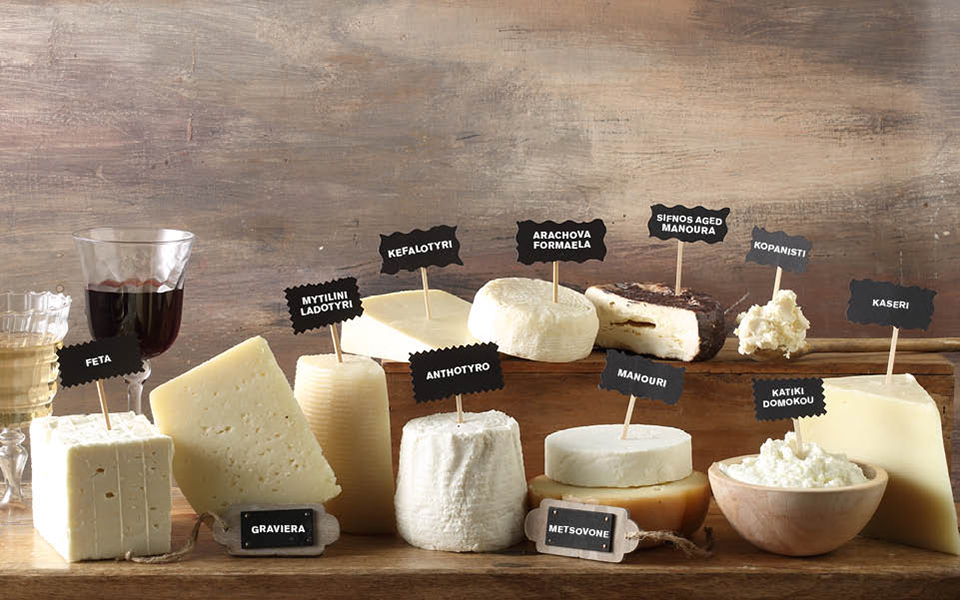Kefalotyri
This hard cheese is quite salty and spicy, with some versions used grated over pasta or for fried saganaki. If serving it raw, choose slightly tangy wines like Xinomavro, Agiorgitiko or Mavrotragano, though a full-bodied sweet wine like Malagousia or Muscat could give it an interesting twist. If served as a saganaki go for a retsina or an aromatic, oily white made from Vidiano. A rosé with strong notes of fruit, like Agiorgitiko, complements the ‘dry’ characteristics of the cheese with its ‘juicy’ fruity elements, while at the same time bringing out its saltiness thanks to its acidity.
Graviera
Mature, light-yellow graviera comes in a vast variety of tastes and textures, and is produced mainly from a mixture of goat and sheep milk, with the exception of the Cycladic islands that make a milder version using cow’s milk. Depending on how long it has been aged, it can be soft and buttery or hard and tangy, like the San Michali variety produced on the island of Syros. The saltier varieties, usually harder as well, are known as kefalograviera and used mainly grated on pasta. All of the varieties are used in cooking, but graviera’s place of honor is alone at the table. A fresh graviera goes better with robust whites with balanced acidity, while the mature, tangier varieties pair beautifully with full-bodied reds. Robola is ideal with its discreet fruity tones, but so is a Vidiano or even a modern retsina paired with a hard, savory graviera.
Kopanisti
Greece’s tangiest and curmudgeonly cheese is made in the Cycladic islands using either cow milk or a mixture of sheep’s and goat’s. It is pallet-numbingly spicy, yellow and creamy, similar to blue cheese. It is eaten only as a table cheese and goes well with sweet tomatoes, which help mellow its aggressive flavor. Few wines can stand up to it, but sweetness is a must. Sweet and even fortified wines can make a perfect partner. A Samos vin de liqueur from the local Muscat variety would be an excellent choice.
Feta
A global emblem of Greece, feta is made of sheep milk (or a mixture of it with goat milk at a proportion of up to 30%) and aged in brine, in wooden barrels or tins. Depending on where it’s produced, it comes in an array of distinctive flavors and textures, from soft to almost cream-like, and from hard and tangy, to crumbly and salty. Whatever its profile, it is a capricious cheese that doesn’t like to have its thunder stolen by wine. The best way to enjoy a good feta is as a snack, dressed in fresh virgin olive oil and a sprinkling of fresh oregano. It is perfect in traditional Greek salad, pies and on the side of oil-rich vegetable casseroles. Τhe characteristic salty and somewhat tart sharp flavor of feta pairs with a fresh, fragrant white wine with balanced acidity like Moschofilero, in keeping with one of the basic tenets: combining savory with sharp.
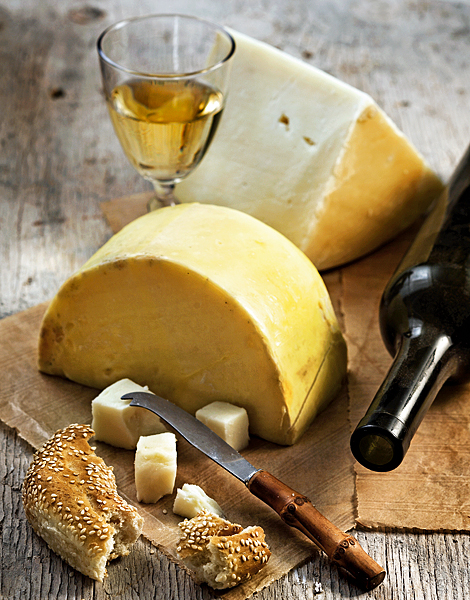
© Petros Andrianopoulos
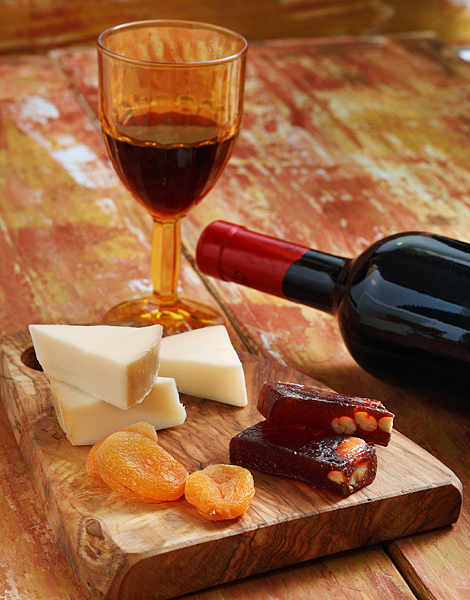
© Petros Andrianopoulos
Anthotyro
A mild, low-fat cheese, anthotyro is made either of sheep or goat milk. Most varieties are unsalted and snow-white, with a solid yet soft texture, smooth milky flavor and mild acidity. In many parts of Greece it is salted and aged to produce some very interesting results. Fresh anthotyro is best friends with fruit and white, dry aromatic wines like Debina, Muscat and Malagousia, even in their sweeter versions. A dryer anthotyro demands spicier, fuller wines like Roditis, Vidiano and Robola. The mild flavor and strong presence of milk in the cheese can be harmoniously combined with dry, white Muscat or even a sweet Muscat of Alexandria. Its flowery aromas and mature grape tones bring out the cheese’s flavor elements.
Metsovone
This is an unrivalled smoked cheese produced in Metsovo, a town in the Pindos mountains in Epirus. Made with sheep and cow milk, it goes through a complex smoking process that endows it an intense yet pleasant flavor that balances well with its buttery character and subtle roasted-nut aromas. It is served mainly as a table cheese, but also fried to increase its flavor impact. It goes with a Vlachiko, a local variety grown in the area, but also pairs beautifully with white wines with strong acidity. Enjoy it with a discreet Debina, a full-bodied Savatiano or a rich Vidiano.
Arachova Formaela
This semi-hard sheep milk cheese, mildly salty and very milky, is usually grilled or fried. Hailing from the Mount Parnassos village of Arachova, it is considered one the best cheeses for crispy fried saganaki, normally served with a drizzle of fresh lemon juice, which gives it an edge and cuts through the oiliness. Pairs well with a full-bodied aromatic white with good acidity. The slightly salty flavor, in combination with its buttery feel, whether raw or cooked, demands a white wine with pronounced acidity and a relatively rich taste, such as those made with Roditis or Assyrtiko.
Sifnos Aged Manoura
Aged manoura is an exciting, spicy cheese that is produced mainly on the island of Sifnos – though also in other parts of Greece – with sheep and goat milk and then matured in wine sediment to give its characteristic purple outer layer and distinctive wine flavor. It is an excellent cheese to eat alone with a glass of sharp red or even sweet wine. One excellent choice is a sweet Samos Muscat, aged in barrels for at least five years. Because of its sweetness, full body, mature character and complex aromas, it strikes a perfect balance with this sophisticated cheese, offering a full aftertaste and acting in a complimentary manner. A Santorini Vinsanto would also make a wonderful match.
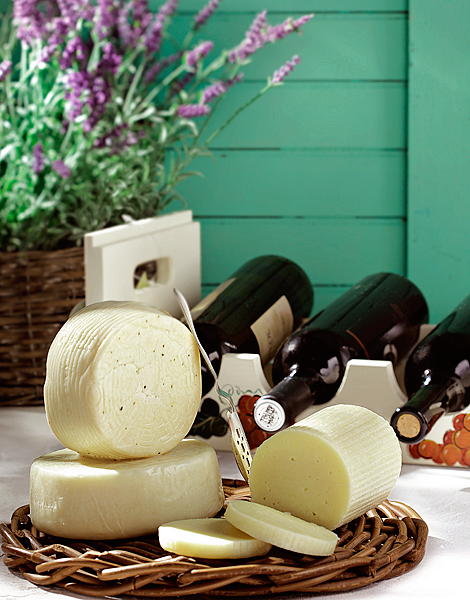
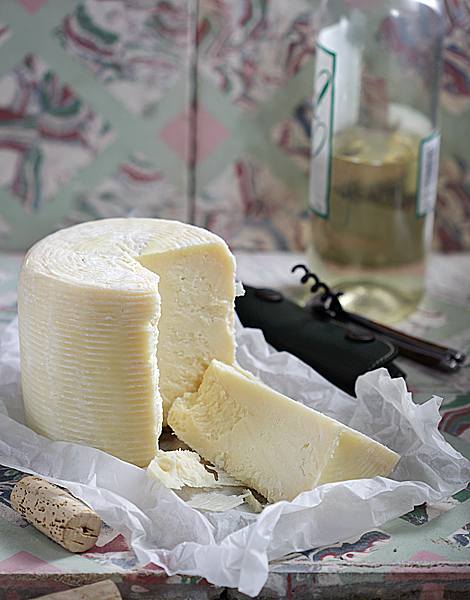
© Petros Andrianopoulos
Mytilini Ladotyri
This is a very special cheese that is aged in olive oil to give it a rich, spicy flavor. It is made of sheep and goat milk, has a full flavor with intense aromas, and makes the perfect meze. It requires a wine of intense personality, nerve and body. From the whites, an Assyrtiko or a retsina, or from the reds, a mature Xinomavro or a light Limnio, would be appropriate. Sommelier Yiannis Kaimenakis suggests “something equally rich, such as a white Nychteri from Santorini, which would cut through the greasy feel on our pallet. Alternatively, try a light red like a Liatiko from Dafnes, which would give the cheese room to showcase its rich flavor.”
Kaseri
This semi-hard yellow sheep’s milk cheese, with its mild, buttery and full-bodied flavor, is one of the most popular in Greece and is used widely in cooking because it melts beautifully. Its aged versions, meanwhile, are nothing short of a revelation: peppery, nutty and with a very strong, rich flavor. Fresh versions are more flexible in terms of wine pairing, but the mature kinds favor full, well-matured reds. Its perfect match is a mild or a spicy red from Agiorgitiko, but it also goes well with a strong white like Roditis.
Katiki Domokou
Greece produces a number of spreadable cheeses other than the extremely popular Katiki from Domokos in central Greece, and some of these enjoy Protected Designation of Origin status, such as Pichtogalo from Hania, Anevato, Galotyri and Xygalo from Sitia. Besides their creamy, rich texture, they also share refreshing acidity. Try the fresher varieties with well-balanced whites like Assyrtiko, Monemvasia and Moschofilero, and the saltier ones with a milder wine, such as dry Muscat or Savatiano. Katiki is a refreshing cheese and a very good match for equally vibrant white wines with attractive aromas like Malagousia or Athiri.
Manouri
Full-fat and lightly salted, this alabaster-white cheese is so rich it tastes almost like butter. Produced mainly in the Thessaly and Macedonia regions, using a combination of goat and sheep milk, it is usually served as a table cheese, drizzled with honey and nuts, but can also be cooked to bring out its wonderful buttery aroma. Full-bodied, though not oily, whites are the best choice, with balanced acidity and a relatively intense bouquet, such as Moschofilero or Malagousia. Pairing it with sweet Muscats with bold acid tones also offers a pleasant surprise. When it is served on the side of oil-rich vegetable casseroles, it goes best with Robola, but also fresh Xinomavro wines. Cooked manouri goes beautifully with a vigorous Assyrtiko, while if it is served raw with honey, nuts or fruit, it pairs very well with a sweet Muscat of Alexandria.

